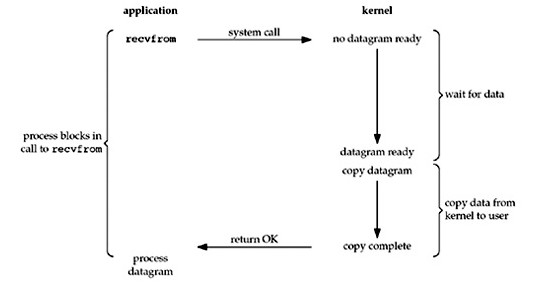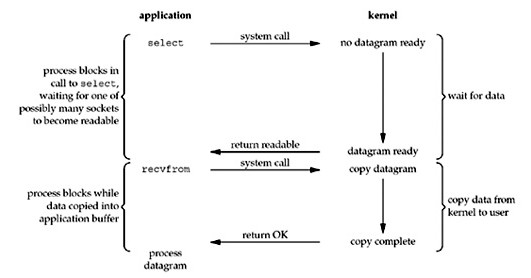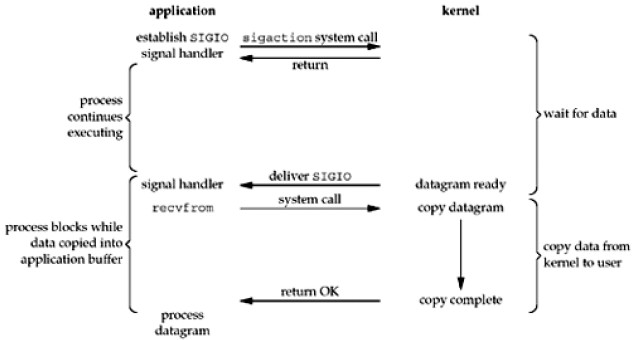IO模型在Richard Stevens的《UNIX网络编程,第一卷》(程序猿必备!)一书中有非常详尽的描述,以下简要介绍,并给出代码示例。
另外比较好的总结性blog,推荐:
使用异步 I/O 大大提高应用程序的性能
IO - 同步,异步,阻塞,非阻塞 (亡羊补牢篇)
常见网络IO模型:阻塞式IO、无阻塞式IO、IO复用、异步IO、信号驱动
阻塞式IO:
在一个进程发出IO请求后,进入阻塞状态,直到内核返回数据,才重新运行,如图:

代码
sever端:
#include <stdio.h>
#include <stdlib.h>
#include <errno.h>
#include <string.h>
#include <netinet/in.h>
#include <sys/socket.h>
#include <unistd.h>
int main()
{
int sockfd, new_fd;
int sin_size, numbytes;
struct sockaddr_in addr, cliaddr;
//创建socket
if((sockfd = socket(AF_INET, SOCK_STREAM, 0)) < 0)
{
perror("createSocket");
return -1;
}
//初始化socket结构
memset(&addr, 0, sizeof(addr));
addr.sin_family = AF_INET;
addr.sin_port = htons(7092);
addr.sin_addr.s_addr = htonl(INADDR_ANY);
//绑定套接口
if(bind(sockfd,(struct sockaddr *)&addr,sizeof(struct sockaddr))==-1)
{
perror("bind");
return -1;
}
//创建监听套接口
if(listen(sockfd,10)==-1)
{
perror("listen");
return -1;
}
printf("server is running!
");
char buff[1024];
//等待连接
while(1)
{
sin_size = sizeof(struct sockaddr_in);
//接受连接
if((new_fd = accept(sockfd, (struct sockaddr *)&cliaddr, (socklen_t*)&sin_size))==-1)
{
perror("accept");
return -1;
}
//生成一个子进程来完成和客户端的会话,父进程继续监听
if(!fork())
{
//读取客户端发来的信息
memset(buff,0,sizeof(buff));
if((numbytes = recv(new_fd,buff,sizeof(buff),0))==-1)
{
perror("recv");
return -1;
}
printf("buff=%s
",buff);
//将从客户端接收到的信息再发回客户端
if(send(new_fd,buff,strlen(buff),0)==-1)
{
perror("send");
}
close(new_fd);
return 0;
}
//父进程关闭new_fd
close(new_fd);
}
close(sockfd);
}
#include <stdio.h>
#include <stdlib.h>
#include <errno.h>
#include <string.h>
#include <netdb.h>
#include <sys/types.h>
#include <netinet/in.h>
#include <sys/socket.h>
#include <unistd.h>
int main(int argc,char *argv[])
{
if(argc!=3)
{
printf("%s: input IP & port
",argv[0]);
return 1;
}
int sockfd,numbytes;
char buf[100] = "hello world";
struct hostent *he;
struct sockaddr_in their_addr;
//将基本名字和地址转换
he = gethostbyname(argv[1]);
//建立一个TCP套接口
if((sockfd = socket(AF_INET,SOCK_STREAM,0))==-1)
{
perror("socket");
exit(1);
}
//初始化结构体
their_addr.sin_family = AF_INET;
their_addr.sin_port = htons(atoi(argv[2]));
their_addr.sin_addr = *((struct in_addr *)he->h_addr);
bzero(&(their_addr.sin_zero),8);
//和服务器建立连接
if(connect(sockfd,(struct sockaddr *)&their_addr,sizeof(struct sockaddr))==-1)
{
perror("connect");
exit(1);
}
//向服务器发送字符串
if(send(sockfd,buf,strlen(buf),0)==-1)
{
perror("send");
exit(1);
}
memset(buf,0,sizeof(buf));
//接受从服务器返回的信息
if((numbytes = recv(sockfd,buf,100,0))==-1)
{
perror("recv");
exit(1);
}
close(sockfd);
return 0;
}
运行:
$ ./bin/server
server is running!
buff=hello world
buff=hello world
$ ./bin/client 10.32.49.10 7092
$ ./bin/client 10.32.49.10 7092
无阻塞式IO:
在一个进程发出IO请求后,不阻塞,如果数据没有准备好,就直接返回错误码,如图:

可以通过fcntl控制socket描述符属性。
int flags;
flag=fcntl(sockfd,F_GETFL,0);
fcntl(sockfd,F_SETFL,flag|O_NONBLOCK)
非阻塞式I/O模型对4种I/O操作返回的错误
读操作:接收缓冲区无数据时返回EWOULDBLOCK
写操作:发送缓冲区无空间时返回EWOULDBLOCK;空间不够时部分拷贝,返回实际拷贝字节数
建立连接:启动3次握手,立刻返回错误EINPROGRESS;服务器客户端在同一主机上connect立即返回成功
接受连接:没有新连接返回EWOULDBLOCK
代码:
server端:
#include <stdio.h>
#include <stdlib.h>
#include <errno.h>
#include <string.h>
#include <netinet/in.h>
#include <sys/socket.h>
#include <unistd.h>
#include <fcntl.h>
int main()
{
int sockfd, new_fd;
int sin_size;
struct sockaddr_in addr, cliaddr;
//创建socket
if((sockfd = socket(AF_INET, SOCK_STREAM, 0)) < 0)
{
perror("createSocket");
return -1;
}
//初始化socket结构
memset(&addr, 0, sizeof(addr));
addr.sin_family = AF_INET;
addr.sin_port = htons(7092);
addr.sin_addr.s_addr = htonl(INADDR_ANY);
//绑定套接口
if(bind(sockfd,(struct sockaddr *)&addr,sizeof(struct sockaddr))==-1)
{
perror("bind");
return -1;
}
//创建监听套接口
if(listen(sockfd,10)==-1)
{
perror("listen");
return -1;
}
printf("server is running!
");
char buff[1024];
//等待连接
while(1)
{
sin_size = sizeof(struct sockaddr_in);
//接受连接
if((new_fd = accept(sockfd, (struct sockaddr *)&cliaddr, (socklen_t*)&sin_size))==-1)
{
perror("accept");
return -1;
}
//生成一个子进程来完成和客户端的会话,父进程继续监听
if(!fork())
{
//设置new_fd无阻塞属性
int flags;
if((flags=fcntl(new_fd, F_GETFL, 0))<0)
{
perror("fcntl F_GETFL");
}
flags |= O_NONBLOCK;
if(fcntl(new_fd, F_SETFL,flags)<0)
{
perror("fcntl F_SETFL");
}
//读取客户端发来的信息
memset(buff,0,sizeof(buff));
while(1)
{
if((recv(new_fd,buff,sizeof(buff),0)) < 0)
{
if(errno==EWOULDBLOCK)
{
perror("recv error, wait....");
sleep(1);
continue;
}
}
else
{
printf("buff=%s
",buff);
}
break;
}
//发送数据
while(1)
{
if(send(new_fd,buff,strlen(buff),0) < 0)
{
if(errno==EWOULDBLOCK)
{
perror("send error, wait....");
sleep(1);
continue;
}
}
else
{
printf("buff=%s
",buff);
}
break;
}
close(new_fd);
return 0;
}
//父进程关闭new_fd
close(new_fd);
}
close(sockfd);
}
client端:
#include <stdio.h>
#include <stdlib.h>
#include <errno.h>
#include <string.h>
#include <netdb.h>
#include <sys/types.h>
#include <netinet/in.h>
#include <sys/socket.h>
#include <unistd.h>
int main(int argc,char *argv[])
{
if(argc!=3)
{
printf("%s: input IP & port
",argv[0]);
return 1;
}
int sockfd,numbytes;
char buf[100] = "hello world";
struct hostent *he;
struct sockaddr_in their_addr;
//将基本名字和地址转换
he = gethostbyname(argv[1]);
//建立一个TCP套接口
if((sockfd = socket(AF_INET,SOCK_STREAM,0))==-1)
{
perror("socket");
exit(1);
}
//初始化结构体
their_addr.sin_family = AF_INET;
their_addr.sin_port = htons(atoi(argv[2]));
their_addr.sin_addr = *((struct in_addr *)he->h_addr);
bzero(&(their_addr.sin_zero),8);
//和服务器建立连接
if(connect(sockfd,(struct sockaddr *)&their_addr,sizeof(struct sockaddr))==-1)
{
perror("connect");
exit(1);
}
sleep(5);
//向服务器发送字符串
if(send(sockfd,buf,strlen(buf),0)==-1)
{
perror("send");
exit(1);
}
memset(buf,0,sizeof(buf));
sleep(5);
//接受从服务器返回的信息
if((numbytes = recv(sockfd,buf,100,0))==-1)
{
perror("recv");
exit(1);
}
close(sockfd);
return 0;
}
运行:
$ ./bin/server
server is running!
recv error, wait....: Resource temporarily unavailable
recv error, wait....: Resource temporarily unavailable
recv error, wait....: Resource temporarily unavailable
recv error, wait....: Resource temporarily unavailable
recv error, wait....: Resource temporarily unavailable
buff=hello world
buff=hello world
$ ./bin/client 10.32.49.10 7092
IO复用:
IO复用阻塞在select、poll或epoll这样的系统调用上,通过这种方式,在不使用多线程的前提下,单个进程可以同时处理多个网络连接的IO。如图:

代码
sever端:
#include <stdio.h>
#include <stdlib.h>
#include <errno.h>
#include <string.h>
#include <netinet/in.h>
#include <sys/socket.h>
#include <unistd.h>
#include <fcntl.h>
#include <netdb.h>
#include <sys/epoll.h>
#define MAXEVENT 1024
int create_server_socket(int& sockfd)
{
struct sockaddr_in addr;
//创建socket
if((sockfd = socket(AF_INET, SOCK_STREAM, 0)) < 0)
{
perror("createSocket");
return -1;
}
//初始化socket结构
memset(&addr, 0, sizeof(addr));
addr.sin_family = AF_INET;
addr.sin_port = htons(7092);
addr.sin_addr.s_addr = htonl(INADDR_ANY);
//绑定套接口
if(bind(sockfd,(struct sockaddr *)&addr,sizeof(struct sockaddr))==-1)
{
perror("bind");
return -1;
}
//创建监听套接口
if(listen(sockfd,10)==-1)
{
perror("listen");
return -1;
}
return 0;
}
int set_socket_non_blocking(int fd)
{
int flags, s;
flags = fcntl (fd, F_GETFL, 0);
if (flags == -1)
{
perror ("fcntl F_GETFL failed");
return -1;
}
flags |= O_NONBLOCK;
s = fcntl (fd, F_SETFL, flags);
if (s == -1)
{
perror ("fcntl F_SETFL failed");
return -1;
}
return 0;
}
int main()
{
int sockfd, efd;
struct epoll_event event;
struct epoll_event *events;
int s;
if(create_server_socket(sockfd) != 0)
{
perror("create server sock failed
");
return 1;
}
set_socket_non_blocking(sockfd);
printf("server is running!
");
//创建一个epoll的句柄
//int epoll_create(int size)
//Since Linux 2.6.8, the size argument is unused. (The kernel dynamically sizes the required data structures without needing this initial hint.)
efd = epoll_create(MAXEVENT);
if (efd == -1)
{
perror ("epoll_create");
abort ();
}
//注册新事件到epoll efd
event.data.fd = sockfd;
event.events = EPOLLIN | EPOLLET;
s = epoll_ctl(efd, EPOLL_CTL_ADD, sockfd, &event);
if (s == -1)
{
perror ("epoll_ctl EPOLL_CTL_ADD failed");
abort ();
}
events = (epoll_event*)calloc(MAXEVENT, sizeof(event));
while (1)
{
int n, i;
n = epoll_wait(efd, events, MAXEVENT, -1);
for (i = 0; i < n; i++)
{
//fd error
if ((events[i].events & EPOLLERR) ||
(events[i].events & EPOLLHUP) ||
(!(events[i].events & EPOLLIN)))
{
perror("epoll error
");
close (events[i].data.fd);
continue;
}
//新连接
else if (sockfd == events[i].data.fd)
{
while (1)
{
struct sockaddr in_addr;
socklen_t in_len;
int infd;
char hbuf[NI_MAXHOST], sbuf[NI_MAXSERV];
//接受连接
in_len = sizeof(in_addr);
infd = accept(sockfd, &in_addr, &in_len);
if (infd == -1)
{
if ((errno == EAGAIN) ||
(errno == EWOULDBLOCK))
{
//已接受所有连接
break;
}
else
{
perror ("accept");
break;
}
}
s = getnameinfo (&in_addr, in_len,
hbuf, sizeof hbuf,
sbuf, sizeof sbuf,
NI_NUMERICHOST | NI_NUMERICSERV);
if (s == 0)
{
printf("Accepted connection on descriptor %d "
"(host=%s, port=%s)
", infd, hbuf, sbuf);
}
/* 设置新接受的socket连接无阻塞*/
s = set_socket_non_blocking (infd);
if (s == -1)
{
return 1;
}
//注册新事件到epoll
event.data.fd = infd;
event.events = EPOLLIN | EPOLLET;
s = epoll_ctl(efd, EPOLL_CTL_ADD, infd, &event);
if (s == -1)
{
perror ("epoll_ctl");
return 1;
}
}
continue;
}
//数据可读
else
{
int done = 0;
while (1)
{
ssize_t count;
char buf[512];
count = read(events[i].data.fd, buf, sizeof(buf));
if(count == -1)
{
//数据读完
if (errno != EAGAIN)
{
perror ("read");
done = 1;
}
break;
}
else if(count == 0)
{
/* End of file. The remote has closed the
connection. */
done = 1;
break;
}
printf("recv: %s
", buf);
}
if (done)
{
printf ("Closed connection on descriptor %d
", events[i].data.fd);
close (events[i].data.fd);
}
}
}
}
free (events);
close(sockfd);
return 0;
}
client端:
#include <stdio.h>
#include <stdlib.h>
#include <errno.h>
#include <string.h>
#include <netdb.h>
#include <sys/types.h>
#include <netinet/in.h>
#include <sys/socket.h>
#include <unistd.h>
int main(int argc,char *argv[])
{
if(argc!=3)
{
printf("%s: input IP & port
",argv[0]);
return 1;
}
int sockfd,numbytes;
char buf[100] = "hello world";
struct hostent *he;
struct sockaddr_in their_addr;
//将基本名字和地址转换
he = gethostbyname(argv[1]);
//建立一个TCP套接口
if((sockfd = socket(AF_INET,SOCK_STREAM,0))==-1)
{
perror("socket");
exit(1);
}
//初始化结构体
their_addr.sin_family = AF_INET;
their_addr.sin_port = htons(atoi(argv[2]));
their_addr.sin_addr = *((struct in_addr *)he->h_addr);
bzero(&(their_addr.sin_zero),8);
//和服务器建立连接
if(connect(sockfd,(struct sockaddr *)&their_addr,sizeof(struct sockaddr))==-1)
{
perror("connect");
exit(1);
}
//向服务器发送字符串
while(1)
{
if(send(sockfd,buf,strlen(buf),0)==-1)
{
perror("send");
exit(1);
}
sleep(2);
}
memset(buf,0,sizeof(buf));
close(sockfd);
return 0;
}
运行:
$ ./bin/server
server is running!
Accepted connection on descriptor 5 (host=10.32.49.10, port=39001)
recv: hello world
recv: hello world
recv: hello world
recv: hello world
./bin/client 10.32.49.10 7092
异步IO:
在一个进程发出IO请求后直接返回,内核在整个操作(包括将数据复制到进程缓冲区)完成后通知进程,如图:

代码
server端:
#include <stdio.h>
#include <stdlib.h>
#include <errno.h>
#include <string.h>
#include <netinet/in.h>
#include <sys/socket.h>
#include <unistd.h>
#include <fcntl.h>
#include <aio.h>
#include <pthread.h>
#define BUF_SIZE 1024
void aio_completion_handler(sigval_t sigval);
void setup_io(int fd, aiocb& my_aiocb)
{
//初始化AIO请求
bzero( (char *)&my_aiocb, sizeof(struct aiocb) );
my_aiocb.aio_fildes = fd;
my_aiocb.aio_buf = malloc(BUF_SIZE+1);
my_aiocb.aio_nbytes = BUF_SIZE;
my_aiocb.aio_offset = 0;
//设置线程回调函数
my_aiocb.aio_sigevent.sigev_notify = SIGEV_THREAD;
my_aiocb.aio_sigevent.sigev_notify_function = aio_completion_handler;
my_aiocb.aio_sigevent.sigev_notify_attributes = NULL;
my_aiocb.aio_sigevent.sigev_value.sival_ptr = &my_aiocb;
}
//回调函数
void aio_completion_handler(sigval_t sigval)
{
struct aiocb *req;
int ret;
req = (struct aiocb *)sigval.sival_ptr;
if (aio_error(req) == 0)
{
if((ret = aio_return(req)) > 0)
{
printf("Thread id %u recv:%s
", (unsigned int)pthread_self(), (char*)req->aio_buf);
}
}
char* buf = (char*)req->aio_buf;
if(send(req->aio_fildes, buf, strlen(buf), 0) == -1)
{
perror("send");
return;
}
close(req->aio_fildes);
return;
}
int main()
{
int sockfd;
int sin_size;
struct sockaddr_in addr, cliaddr;
//创建socket
if((sockfd = socket(AF_INET, SOCK_STREAM, 0)) < 0)
{
perror("createSocket");
return -1;
}
//初始化socket结构
memset(&addr, 0, sizeof(addr));
addr.sin_family = AF_INET;
addr.sin_port = htons(7092);
addr.sin_addr.s_addr = htonl(INADDR_ANY);
//绑定套接口
if(bind(sockfd,(struct sockaddr *)&addr,sizeof(struct sockaddr))==-1)
{
perror("bind");
return -1;
}
//创建监听套接口
if(listen(sockfd,10)==-1)
{
perror("listen");
return -1;
}
printf("server is running!
");
//等待连接
while(1)
{
int new_fd;
struct aiocb my_aiocb;
sin_size = sizeof(struct sockaddr_in);
//接受连接
if((new_fd = accept(sockfd, (struct sockaddr *)&cliaddr, (socklen_t*)&sin_size))==-1)
{
perror("accept");
return -1;
}
printf("Thread id %u accept connect, fd: %d
", (unsigned int)pthread_self(), new_fd);
setup_io(new_fd, my_aiocb);
aio_read(&my_aiocb);
}
close(sockfd);
}
client端:
运行:
$ ./bin/server
server is running!
Thread id 2505492000 accept connect, fd: 4
Thread id 1084246368 recv:hello world
(注意:线程ID不一样)
$ ./bin/client 10.32.49.10 7092
recv: hello world
信号驱动IO:
使用信号驱动I/O时,当网络套接字可读后,内核通过发送SIGIO信号通知应用进程,于是应用可以开始读取数据。如图:

为了让套接字描述符可以工作于信号驱动I/O模式,应用进程必须完成如下三步设置:
1.注册SIGIO信号处理程序。(安装信号处理器)
2.使用fcntl的F_SETOWN命令,设置套接字所有者。(设置套接字的所有者)
3.使用fcntl的F_SETFL命令,置O_ASYNC标志,允许套接字信号驱动I/O。(允许这个套接字进行信号输入输出)
注意,必须保证在设置套接字所有者之前,向系统注册信号处理程序,否则就有可能在fcntl调用后,信号处理程序注册前内核向应用交付SIGIO信号,导致应用丢失此信号。
在UDP编程中使用信号驱动I/O,此时SIGIO信号产生于下面两种情况:
套接字收到一个数据报。
套接字上发生了异步错误。
因此,当应用因为收到一个UDP数据报而产生的SIGIO时,要么可以调用recvfrom读取该数据报,要么得到一个异步错误。
对于TCP编程,信号驱动I/O就没有太大意义了,因为对于流式套接字而言,有很多情况都可以导致SIGIO产生,而应用又无法区分是什么具体情况导致该信号产生的
信号驱动IO模型在网络编程中极少使用,这里不写例子了,有兴趣的同学可以参考:http://blog.csdn.net/yskcg/article/details/6021275
例子源码打包下载:
http://download.csdn.net/detail/yfkiss/4288465